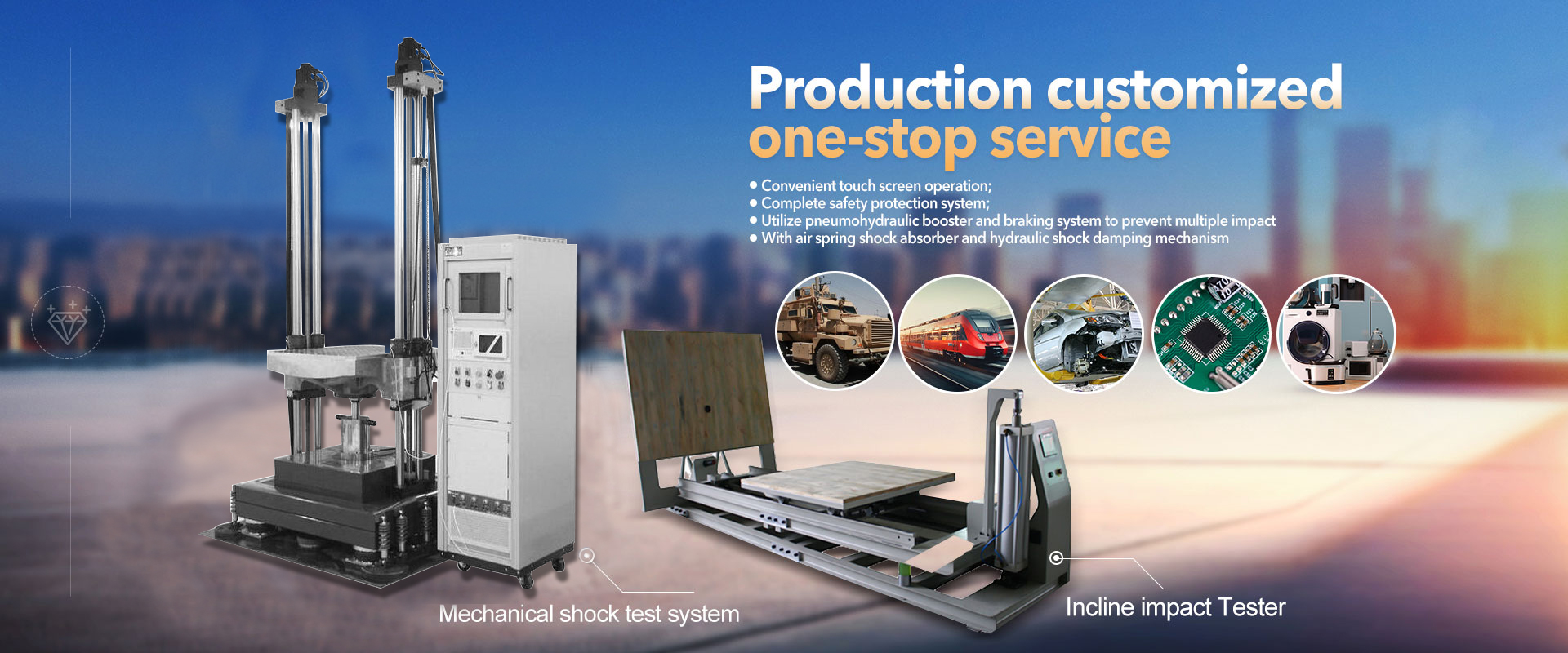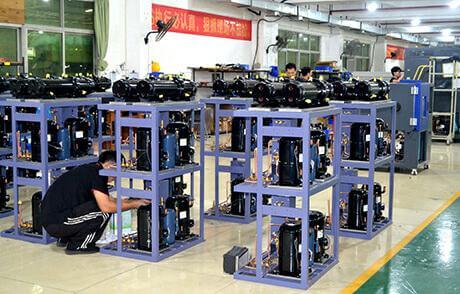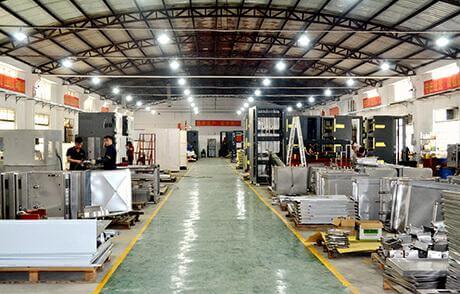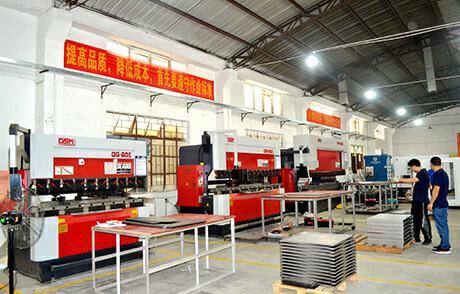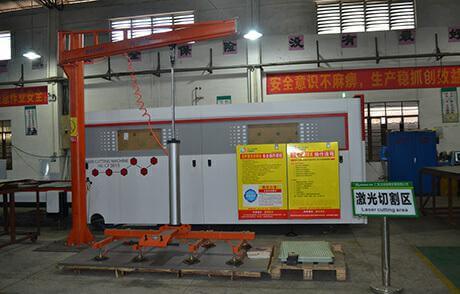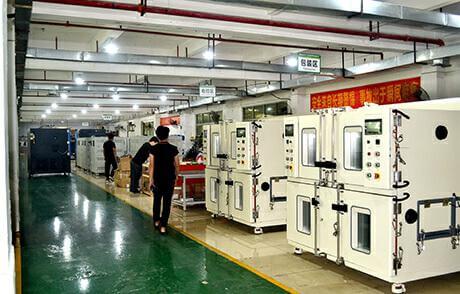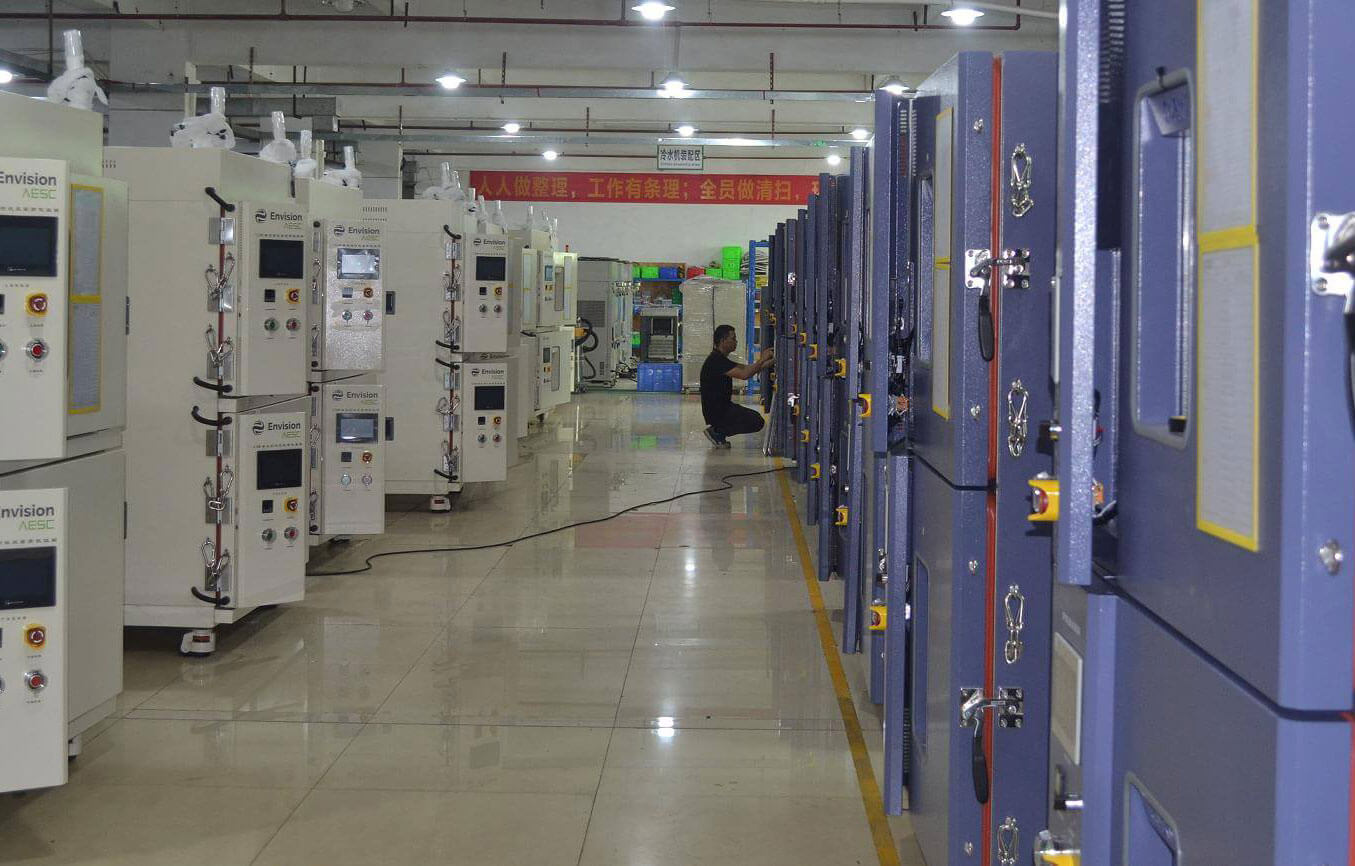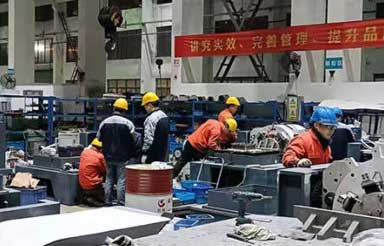
Shock Testing Machine Manufacturer
- A high rigidity table makes high reproducibility
- Superior shock pads with long service life
- Low maintenance and up to 15 years of service life.
- Cycle time–up to 120 shock impacts per minute
- Customized table mounting patterns are available
- Operation is simple, and the test waveform is ideal and stable.
- Provide shock testing machines for hundreds of well-known enterprises and laboratories
Shock Testing Machine Application:
A Shock testing machine is multi-functional testing equipment that can perform shock testing according to various national and international standards, such as IS, MIL, EN, ISO, IEC, DEF, and ASTM standards.
The Linkotest shock test machine can carry out shock tests with sinusoidal half-sine waves, trapezoidal waves & sawtooth wave pulses from micro devices to large products. We test the shock resistance of products by applying high acceleration shock to compact and lightweight products such as personal computer parts and mobile devices (mobile phones, smartphones, tablets, notebook PCs, etc.). Also, test the strength and continuous impact resistance of the specimen.
Features:
- An idea half-sine shock wave can be generated by replacing a programmer.
- A high rigidity table makes high reproducibility
- Low noise and low vibration by using an anti-vibration base and sound insulation rack.
- Automatic control ensures operability and safety
- Shock acceleration up to 300,000m/s² (30,000G) by shock amplifier
- Continuous shock test
Featured Shock Test Machine
Linkotest offers a full range of shock test machines

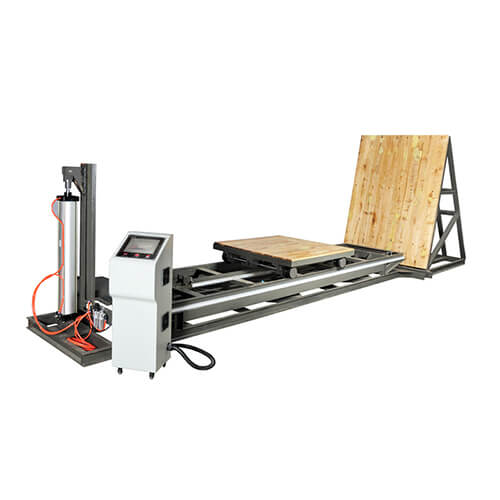
Incline Impact Tester
Incline Impact testers are used to simulate the ability of product packaging to resist impact damage in real environments, such as handling, stacking of shelves, sliding of motors, loading and unloading of locomotives, transportation of products, etc. Several sizes are available for testing palletized loads and single products up to 600kg.
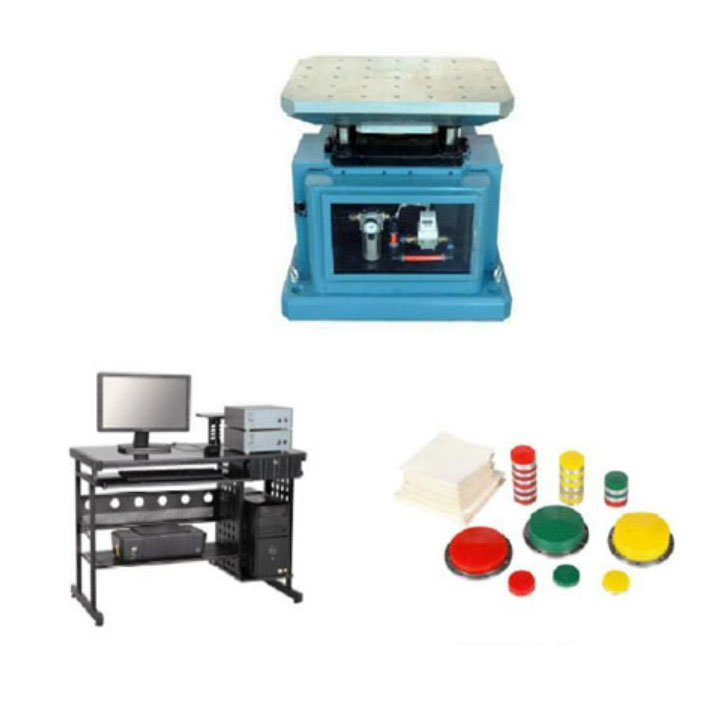
Bump Test Machine
All Bump Machines are PC-controlled pneumatic shock testers that perform accurate, repeatable laboratory and production shock testing of samples weighing up to 1000 kg, depending on the model. With shock pulse programmers generate short and long duration half sine shock pulses to meet stringent automotive, military and industrial specifications or individual testing requirements. Generated waveforms meet typical military specifications, including MIL-STD-202, MIL-STD-750, MILSTD-810, and MIL-STD-883.
Shock Testing Machine FAQ Guide
Mechanical shock and vibration test is an important test for electronic industry manufacturers. To obtain reliable data on how a product performs during use, its durability, and points of failure, it is important to engage the services of a testing laboratory with the expertise, equipment, and testing procedures that best suit your testing specifications and requirements. Here is a complete guide for shock test machine:
1. What is a shock testing machine?
A shock testing machine is multi-functional testing equipment that can perform shock testing according to various national and international standards, such as IS, MIL, EN, ISO, IEC, DEF, and ASTM standards. It is also called a mechanical shock test machine, or pneumatic shock test machine.
Generally, shock testing is a dramatic transfer of energy into a mechanical system to test the survivability of the system under drops, impacts, shocks, falls, explosions, or any other source of transient vibration. The duration of the shock pulse varies from a few milliseconds to a minute.
In addition, shock testing determines the ability of the package to resist sudden shocks and shocks during transportation and handling. The horizontal shock test machine can control the impact, analyze the load behavior, and save the economic cost for the enterprise.
Last but not least, shock testing accurately measures the vulnerability of products and assesses how they respond to specific shock inputs. Shock test data is critical information in determining whether a product can withstand its intended sales and use environment. For any mechanical shock testing application, Linkotest has built a shock testing system to meet your needs.
2. Why do companies use shock testing machines?
Packaging optimization is gaining more and more attention, not only for companies serving wholesalers but also for companies engaged in e-commerce, for whom it is important that products reach their final customers in perfect condition. Therefore, the shock test machine is an important tool to improve the distribution cycle.
During this process, it is common for packages to suffer different types of shocks that can affect their content and integrity. To prevent these damages, there are shipping simulation solutions on the market, such as shock test machines, whose mission is to perform shock testing to help companies optimize their packaging.
In addition, shock testing methods can be used to test the stability of the product, as well as its behavior shock transportation and handling, analyzing its weaknesses.
Using a shock testing machine can save you money. We know this is not the answer you think, but it is correct. Producing high-quality products is your top priority. However, in order to increase profits, you need to sell your product to more customers. This is where the shock test machine comes into play. Your package or container must be able to withstand the thousands of vibrations and shocks you may encounter during shipping. Test it with a reliable machine and you’ll find far less damage in transit.
3. What is the basic structure of a shock testing machine?
The different types of shock test machines have different basic structures. Here is the basic structure for every shock testing machine:
1) Mechanical shock test system
Mechanical shock tester is also known as vertical free fall shock test system, mechanical impact test simulation products in the production process, handling process, transportation process, and even use, will be subject to mechanical impact, and mechanical impact test through the equipment to simulate the impact generated in these processes to verify the ability of the product to withstand impact. The impact test waveform is obtained by lifting the test table to the height of the test and then impacting the waveform generator as a free fall and then stopping the secondary bounce through the brake system to achieve precise control.
2) Incline impact tester
The incline impact tester simulates horizontal shocks during ship loading and unloading and effects that affect load stability and safety.
It uses gravity for testing. In this case, the platform carrying the load will slide along the track on the slope, providing a maximum shock velocity of 2.5 m/s. This speed can be increased if the client desires.
3) Horizontal shock testing machine
The horizontal shock simulator simulates horizontal shocks that may affect the safety and stability of the load during the transportation or handling of goods. The shock tester uses an electric motor to push the load onto the cylinder, which can control the shock wave.
In this way, the shock wave simulator offers a more advanced solution: a cylinder filled with nitrogen can adjust the pressure in the shock wave region, which makes it possible to program the shock wave.
4. How many types of shock testing equipment are available in the market?
In the current market, there are three main types of shock testing machines available:
1) Mechanical shock machine
A mechanical shock test machine is specialized for performing half sine, trapezoidal and sawtooth shock pulse waveforms by simplifying the programmer system. This is the simplest model in our shock test machine series. Table size range from 200mm ~ to 2000 mm. The mechanical shock machines are applicable for computer parts, digital cameras, smartphones, tablets, displays, household appliances, mobile products, optical components, connectors, batteries, etc
Here are the advantages of the mechanical shock machines:
- High Reproducibility
- Easy Maintenance for Long-Term Usage
- Easy-to-Use Test Settings
- Simple Setting by Simple Construction
- Superior shock pads with long service life
- With shock pulse, programmers generate short and long duration half sine shock pulses
- Dual Mass Shock Amplifiers to generate extremely high acceleration levels (10,000g+)
2) Incline Impact Tester
This is a test that simulates how product packaging will perform in an actual environment, such as handling, stacking shelves, sliding motors, loading, and unloading locomotives, transportation of products, etc.
The incline impact tester can also be used as common test equipment for inclined impact in scientific research institutions, colleges and universities, packaging technology testing centers, packaging material manufacturers, and foreign trade, transportation, and other departments. BV’s ISTA testing standard includes the incline impact tester
Here are the advantages of the inclined impact tester:
- Flexible positioning electric pulley block is convenient to simply fix positions and achieve needed velocity change values
- Low tackle height is beneficial for test specimen installation
- Tackle table-board can be adjusted to horizontal status, which is convenient for users to install test specimen
- The remote control can fully guarantee test personnel’s safety
3)Bump Test Machine
All bump test machines are PC-controlled pneumatic shock testers that perform accurate, repeatable laboratory and production shock testing of samples weighing up to 1000 kg, depending on the model.
With shock pulse, programmers generate short and long-duration half-sine shock pulses to meet stringent automotive, military, and industrial specifications or individual testing requirements. Generated waveforms meet typical military specifications, including MIL-STD-202, MIL-STD-750, MILSTD-810, and MIL-STD-883.
Here are the advantages of the bump test machines:
- Highly reproducible resonance-free half-sine shocks
- Integrated seismic mass
- Test Specimen Weights Up to 1,000kg
- Shock Durations from 0.5ms to 18ms
- Single or multiple drop cycles at a rate of up to 120 cycles per minute
- Compliance with MIL-STD-202, MIL-STD-750, MIL-STD-810, and MIL-STD-883
- With shock pulse, programmers generate short and long duration half sine shock pulses
5. How much does a shock testing machine cost?
It can cost a few thousand dollars to tens of thousands of dollars, depending on its size and functions.
6. How to use a shock testing machine?
Shock testing methods are included in all packaging test protocols. International regulations and standards such as ISTA, ASTM, ISO, and MIL-STD establish different procedures for the performance of these tests. Generally includes the following steps:
- Properly mount both the sample and the accelerometer on the test table
- Enter the test conditions, the test height and the number of tests to be performed in the software of the measuring system
- Execute the test.
- Review test data and sample status
- Print test report
7. How to choose a shock testing machine?
The type of machine used to generate a classical shock pulse is determined by four factors: the mass of the product being tested, the desired amplitude, the pulse duration, and the pulse shape.
In selecting a suitable shock testing system, it is important to properly define the required velocity change. Δv(m/s) for performing a shock test. Take the following test conditions into account and calculate the required velocity change to judge the rated capabilities of the shock testing system.
1) Quotation Required Information
Sample information
- a. Dimensions of samples and fixtures
- b. Weight of sample and fixture
Test condition
- a. Half-sine wave
- b. Sawtooth wave
- c. Trapezoidal wave
Control & Measurement Instrument
- a. Number of input channels
- b. Number of accelerometers
2) Calculation Of Required Velocity Change
Calculate the required velocity change, Δv for your test as follows
- 1. Half-sine wave:△v=2/πAD×10-3
- 2. Sawtooth wave:△v=0.5AD×10-3
- 3. Trapezoidal wave:△v=0.9AD×10-3
Δv: Velocity change (m/s)
- A: Test Acceleration ( g)
- D: Pulse duration
Example: Sample size 300x300mm Sample weight: 30kg Test acceleration: 150g, Duration: 6ms
The required velocity change for the half-sine wave is calculated as
Δv=2/3.14x150x9.8×6/1000=5.62m/s
If some test condition exceeds its rated capability, make a choice of a suitable shock testing system again and calculate the required velocity force.
8. What is a mechanical shock?
Three types of shock motion can be distinguished: impulsive, step, and complicated oscillation type. Step shocks and impulsive shocks are common shocks that typically occur at the shock’s source. Impulsive shocks have a duration that is shorter than the system’s inherent half-cycle, whereas step shocks have abrupt changes in system energy (such as step motion brought on by a quick push). Following the transfer of the shock reaction motion, the system primarily produces the complex oscillatory shock. In actuality, the majority of frequently occurring shock motions are of the complex oscillation kind. Their frequency content is quite rich, having a theoretical frequency range of 0 to +, according to the frequency domain properties.
Shock tests should attempt to imitate and get as near to the real environment as possible and should be reproducible in order to determine whether a product can sustain an impact environment. For the basic impact environment, the shock test equipment with a basic pulse impact test equivalent to it should reflect the actual impact environment of the product.
When testing in complicated impact environments, it is best to first analyze the shock response spectrum on the impact excitation source before conducting an impulse test on the shock test equipment using a similar shock response spectrum. The current trend is to demand a shock with a similar time course and similar impact response excitation.
9. What are the mechanical shock test standards?
There is still no universal test procedure since the effects of environmental factors are so complex. Impact test specifications are outlined in JGB 150, GB 2423, and MIL-STD-810E. Ten different impact test types are offered by JGB 150, which includes four impact simulation methodologies.
Some of them, like the impact test used in transportation and bench tipping, are extremely archaic. The impact response spectrum test is one example of a test that has been more accurately modeled based on the failure mechanism and failure mode generated by the impact excitation. Because the test’s shock response spectrum effect is more closely related to how the environment will really be used, it can more thoroughly reveal any failure brought on by the impact environment, which is why it should take precedence in the standard. Because test equipment for simulating the shock response spectrum and actual measurement data are both lacking, it is frequently not possible to use the simulation of the impact response spectrum and must instead use the recommended shock waveform. The shock to which the product is exposed is a complicated transient vibration, thus it is impossible to mimic the actual shock vibration environment in practice using the recommended half-sine wave, post-peak sawtooth wave.
The fundamental pulse waveform, peak acceleration, corresponding nominal pulse duration, corresponding amount of velocity change, tolerance range of these parameters, number of impacts, impact direction, etc. are all included in the shock test criteria.
1) Basic pulse waveform
(1) Half-sine wave
A half-sine wave is a term for a sine wave’s half cycle. The half-sine wave pulse is suitable for simulating the impact effect caused by the impact of the linear system or the deceleration of the linear system, such as the impact of elastic structures, etc. This waveform is most commonly used in impact tests.
(2) Trapezoidal wave
A trapezoidal waveform is a symmetrical quadrilateral waveform with the quick rise and fall times. It outperforms a half-sine pulse in terms of response over a wider frequency range. This shock waveform can be used if the purpose of the test is to simulate the effects of a shock environment such as that caused by a space probe or satellite exploding bolts.
(3) Sawtooth wave
The sawtooth pulse has a more uniform response spectrum than half-sine and trapezoidal pulses, while the post-peak sawtooth wave is an asymmetrical triangle waveform with a rapid fall time.
- Half Sine: Duration (D) is measured on an abscissa located at 10% of the peak acceleration (Ap).
- Sawtooth: Duration (D) is measured on a zero acceleration abscissa.
- Square Wave: Duration (D) is measured on an abscissa at 90% of the peak acceleration (Ap).
2) Test level for shock test
The pulse waveform and test level are specified in GB/T 2423.5-1995; one of the pulse waveforms and one of the test levels listed in Table 1 may be utilized for the test and the specified velocity change.
| Peak acceleration (A) | Pulse duration (D) | Velocity change (△v) | |||
| M/s² | G(9.8m/s²) | ms | Half-sine
△v=2/πxAD×10-3 |
Sawtooth
△v=0.5AD×10-3 |
Trapezoidal
△v=0.9AD×10-3 |
| 50 | 5 | 30 | 1.0 | —- | —- |
| 150 | 15 | 11 | 1.0 | 0.8 | 1.5 |
| 300 | 30 | 18 | 3.4 | 2.6 | 4.8 |
| 300 | 30 | 11 | 2.1 | 1.6 | 2.9 |
| 300 | 30 | 6 | 1.1 | 0.9 | 1.6 |
| 500 | 50 | 11 | 3.4 | 2.7 | 4.9 |
| 500 | 50 | 3 | 0.9 | 0.7 | 1.3 |
| 1000 | 100 | 11 | 6.9 | 5.4 | 9.7 |
| 1000 | 100 | 6 | 3.7 | 2.9 | 5.3 |
| 2000 | 200 | 6 | 7.5 | 5.9 | 10.6 |
| 2000 | 200 | 3 | 3.7 | 2.9 | 5.3 |
| 5000 | 500 | 1 | 3.1 | —- | —- |
| 10000 | 1000 | 1 | 6.2 | —- | —- |
| 15000 | 1500 | 0.5 | 4.7 | —- | —- |
| 30000 | 3000 | 0.2 | 3.7 | —- | —- |
10. Mechanical shock test method
At present, there are mainly three kinds of shock test methods:
1) Standard shock test method
This method specifies the tolerance range of various pulse waveforms as well as the shock pulse waveform in advance. There are different test levels of shock tests that are conducted according on the peak acceleration of the prescribed pulse waveform, the pulse duration, the number of pulses, etc.
It is widely used both at home and abroad, such as the International Electrotechnical Commission standard IEC 68-2-27Ea “impact test method,” IEC 68-2-29Eb: “impact test method,” and national standards. This is because this kind of shock pulse is relatively simple to generate in the lab with test equipment, and this method can better simulate the mechanical damage caused by a shock in the actual use environment of the product.
2) Shock response spectrum test method
The term “shock spectrum” is commonly used to refer to the shock response spectrum, which is a crucial idea. The shock spectrum has been adopted as one of the techniques to describe the shock environment by the International Electrotechnical Commission (IEC), the technical committees connected to the International Organization for Standardization (ISO), and my nation’s national standards. This test procedure is relatively new, scientific, and logical.
This technique studies the damage capacity of the impact motion to the product structure by simulating the impact of the impact motion on the product structure using the shock response spectrum. It is quite helpful in figuring out how strong the product structure is. A random vibration table makes it simple and convenient to conduct this test method.
3) Special impact test method
The structure of the shock machine, technical requirements, operational procedures, movement pattern, specimen installation, etc. are all specified using this method. To ensure that the test results meet the standards, the operator merely needs to adhere to the specifications’ requirements for operation and completion of the test processes. This test procedure is primarily used to impact test shipboard motors, electrical, and electronic equipment.
The volume and mass of the sample will be a major limiting factor for the above two testing procedures because the motors, electrical appliances, and electronic equipment utilized on ships are often enormous in both volume and mass. The specification of a test procedure in a standardized format is therefore more practical.


